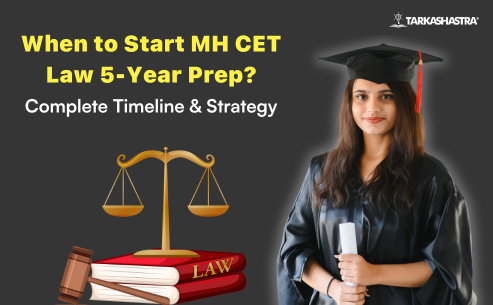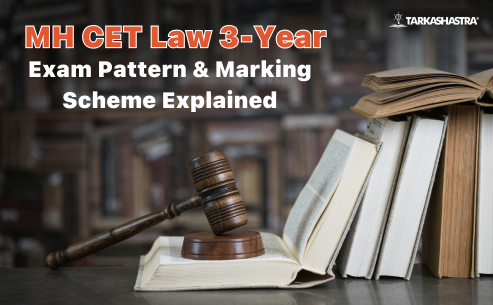The Big Question: When Should You Choose Law?
In the last decade, Law has evolved from a conventional profession to one of the most sought-after career domains in India. Whether it’s corporate law, policy consulting, intellectual property, cyber law, or international arbitration, today’s lawyers shape the country’s business and governance decisions.
However, aspiring lawyers in 2026 face a vital dilemma right at the beginning of their journey — Should they pursue law immediately after Class 12 through a 5-Year Integrated Program, or wait until graduation and then opt for a 3-Year LL.B?
Both paths ultimately lead to the same professional destination — the LL.B degree recognised by the Bar Council of India. Still, the journey, exposure, and career timeline differ significantly.
- The 5-Year route (after 12th) integrates law with disciplines such as arts, business, or management. It allows students to start early through exams like CLAT, AILET, SLAT, MH CET Law 5-Year, NLAT, and Christ University Entrance Test.
- On the other hand, the 3-Year LL.B route is for graduates who decide later — commonly after earning degrees in commerce, engineering, humanities, or management — and appear for MH CET Law 3-Year, DU LL.B, or LSAT–India.
Choosing between the two depends on clarity of career vision, maturity level, financial planning, and long-term goals.
At Tarkashastra, mentors often advise students: “Law is not just about starting early, it’s about starting right.”
Whether you’re preparing for CLAT, AILET, SLAT, NLAT, MH CET Law, or Christ University Entrance Test, understanding both routes will help you make an informed decision for your legal future.
Understanding the Two Law Pathways in India
Before deciding when to pursue law, it’s essential to understand how the Indian legal education system is structured. Broadly, there are two major pathways to becoming a lawyer in India:
- The 5-Year Integrated Law Program (After Class 12)
- The 3-Year LL.B Program (After Graduation)
Let’s explore both in detail.
(A) 5-Year Integrated Law Program (After 12th)
The 5-Year Integrated Law Program combines a bachelor’s degree (like BA, BBA, B.Com, or B.Sc) with a Bachelor of Laws (LL.B). This program allows students to begin their legal education immediately after Class 12 without pursuing a separate graduation degree.
Key Features:
- Duration: 5 years (10 semesters)
- Eligibility: Class 12 passed (any stream) with a minimum 45–50% aggregate (varies by exam)
- Focus: Foundational subjects (Political Science, Sociology, Business, Economics) + Legal Studies
- Entry Exams:
- CLAT (Common Law Admission Test): Conducted by the Consortium of NLUs for 5-year integrated LLB at 24+ National Law Universities and many reputed private law schools.
- AILET (All India Law Entrance Test): Conducted by NLU Delhi for its 5-year BA LLB program.
- SLAT (Symbiosis Law Admission Test): Conducted by Symbiosis International (Deemed University) for SLS (Pune, Noida, Nagpur, Hyderabad) for BA LLB/BBA LLB.
- MH CET Law (Maharashtra Common Entrance Test): Conducted for admission to 5-year LLB programs in colleges across Maharashtra.
- CUET (Common University Entrance Test) for Law: For 5-year integrated law programs at selected central universities.
- Christ University Law Entrance Test (CUET – not the same as NTA CUET): For Christ University’s 5-year law programs.
This route is ideal for students who are sure about pursuing law early, as it saves two years of separate graduation and offers integrated exposure from day one.
(B) 3-Year LL.B Program (After Graduation)
The 3-Year LL.B Program is a postgraduate route for students who decide to study law after completing their graduation in any discipline — Arts, Commerce, Science, or Engineering.
Key Features:
- Duration: 3 years (6 semesters)
- Eligibility: Graduate in any field with 45–50% aggregate
- Focus: Core legal education — Constitutional Law, Criminal Law, Contract Law, Jurisprudence, etc.
- Entry Exams:
- CLAT (Common Law Admission Test) PG: For admission to 3-year LLB at some NLUs.
- AILET (All India Law Entrance Test): Conducted by NLU Delhi for its 3-year LLB program.
- NLSAT (National Law School Admission Test): Conducted by NLSIU Bangalore for its 3-year LLB program.
- MH CET Law: Maharashtra Common Entrance Test Law for 3-year LLB courses in Maharashtra.
This route is perfect for candidates who develop an interest in law later, wish to switch careers, or seek maturity and clarity before entering the legal profession.
Benefits of Pursuing Law After 12th (5-Year Route)
Choosing the 5-Year Integrated Law Program after Class 12 can be a transformative decision for students who are confident about pursuing a legal career early on. This route is a direct entry into the professional world of law, offering a blend of academic depth, practical exposure, and career acceleration.
1) Early Start and Career Advantage
By joining a 5-year integrated program, students save two academic years compared to those who complete graduation first and then opt for a 3-year LL.B. This head-start means that by the age of 22 or 23, you graduate as a law professional ready to appear before courts, join law firms, or pursue higher studies abroad.
2) Integrated Learning Approach
These programs integrate law with other disciplines like Arts, Business, Commerce, or Social Sciences — resulting in degrees such as BA LL.B, BBA LL.B, or B.Com LL.B. This multidisciplinary approach enhances a student’s understanding of society, economics, and governance — all crucial for interpreting and applying law effectively.
3) Continuous Skill Development
From the very first semester, students are exposed to moot courts, debates, research papers, and internships under advocates or firms. This continuous, hands-on learning environment builds strong legal reasoning, drafting, and public-speaking skills by the time they graduate.
4) Cost and Time Efficiency
Since this course merges two degrees into one, it reduces overall education cost and duration. Students complete both undergraduate and law studies in five years, making it a more economical and time-saving route for those focused on a legal career.
5) Better Preparation for Competitive Exams
Students from the 5-year law programs are well-positioned to prepare for Judiciary exams, UPSC, or LL.M. admissions early in their careers. The continuous academic exposure helps them develop legal aptitude, comprehension, and reasoning — all vital for national-level examinations.
Top Entrance Exams for 5-Year Law Programs (2026 Intake)
| Entrance Exam | Conducting Body | Leading Colleges |
| CLAT (UG) | Consortium of NLUs | NLSIU Bengaluru, NALSAR Hyderabad, WBNUJS Kolkata, NLU Jodhpur, NLIU Bhopal |
| AILET (UG) | NLU Delhi | National Law University, Delhi |
| SLAT | Symbiosis International (Deemed University) | Symbiosis Law School – Pune, Noida, Nagpur, Hyderabad |
| MH CET Law (5-Year) | State CET Cell, Maharashtra | GLC Mumbai, ILS Pune, Pravin Gandhi Law College, DES Navalmal Firodia |
| CUET (Law) | NTA | Central Universities offering Integrated Law Programs |
| Christ University Entrance Test (Law) | Christ (Deemed-to-be University) | School of Law, Christ University, Bengaluru |
Benefits of Pursuing Law After Graduation (3-Year Route)
For many aspirants, the decision to pursue law comes after completing a bachelor’s degree in another field — be it Arts, Commerce, Science, or Engineering. The 3-Year LL.B. Program is designed for students who discover their interest in legal studies later or wish to switch careers after graduation.
Despite being shorter in duration, this pathway offers immense scope for personal growth, professional flexibility, and diverse career outcomes.
1) Clarity and Maturity in Decision-Making
Students entering a 3-Year LL.B program already have the maturity and academic discipline gained from their undergraduate studies. This translates into focused classroom participation, stronger analytical reasoning, and better career planning. Such clarity often helps them align law with other domains like management, public policy, or technology.
2) Ideal for Career Switchers and Multidisciplinary Professionals
This route welcomes graduates from varied academic backgrounds — for example, engineers venturing into intellectual-property law, commerce graduates moving toward corporate law and taxation, or humanities graduates pursuing policy and human-rights law. Their prior academic exposure adds an extra dimension to their legal understanding and opens cross-disciplinary opportunities.
3) Balanced Duration and Focused Curriculum
The 3-Year LL.B. is divided into six semesters, each focusing exclusively on core law subjects such as Constitutional Law, Criminal Law, Contract Law, Property Law, Company Law, Jurisprudence, and Evidence Act. The absence of unrelated subjects allows for intense legal immersion and quicker professional readiness.
4) Strong Networking and Peer Exposure
Law colleges offering the 3-Year course usually attract a diverse student pool — fresh graduates, working professionals, UPSC aspirants, and even entrepreneurs. This diversity enriches discussions, enhances peer learning, and builds a strong network of like-minded future practitioners, which later helps in internships and placements.
5) Wide Career Scope Post-Graduation
Graduates from 3-Year LL.B programs enter the same professional world as 5-Year law graduates — whether litigation, judiciary, academia, or the corporate sector. Several well-known lawyers, judges, and bureaucrats in India have followed this route, proving that starting late doesn’t limit success.
Top Entrance Exams for 3-Year LL.B Programs (2026 Cycle)
| Entrance Exam | Conducting Body | Leading Colleges / Universities |
| MH CET Law (3-Year) | State CET Cell, Maharashtra | GLC Mumbai, ILS Pune, Pravin Gandhi Law College |
| CLAT (PG) | Consortium of NLUs | NLSIU Bengaluru, CNLU Patna, NLU Odhisa, NLU Visakhapatnam |
| NLSAT (3-Year LL.B) | NLSIU Bengaluru | National Law School of India University (NLSIU) |
| AILET (PG/3-Year) | NLU Delhi | National Law University Delhi |
Comparing Both Routes – Which Suits You Better?
Both the 5-Year Integrated LL.B. and the 3-Year LL.B. lead to the same professional qualification and recognition by the Bar Council of India. Yet, the journey, exposure, and career readiness differ in crucial ways. Understanding these differences helps you decide which path aligns with your goals, timing, and mindset.
1) Academic Duration and Start Age
| Factor | 5-Year Integrated Law | 3-Year LL.B |
| When You Start | After Class 12 | After Graduation |
| Age at Graduation | Around 22–23 years | Around 24–25 years |
| Course Duration | 5 Years (10 semesters) | 3 Years (6 semesters) |
| Outcome | Dual degree – BA LL.B / BBA LL.B / B.Com LL.B | LL.B (Bachelor of Laws) |
If you want to enter the legal profession early, the 5-Year program gives you a two-year edge.
However, if you value academic maturity and diverse exposure, the 3-Year route lets you decide after graduation.
2) Curriculum and Learning Focus
- 5-Year Programs blend law + interdisciplinary subjects such as Political Science, Economics, and Management.
- They’re ideal for students who wish to connect legal reasoning with social or business realities.
- 3-Year Programs are intensive and law-exclusive, focusing solely on statutes, case laws, and procedural training — best for graduates ready for professional specialisation.
3) Exposure and Networking
The 5-Year course emphasises moot courts, legal aid clinics, internships, and student-run journals from the first year, fostering early professional exposure.
In contrast, 3-Year programs draw diverse peers — engineers, commerce graduates, civil-service aspirants — creating intellectually richer discussions and multidisciplinary networks.
4) Placement and Career Timeline
Top National Law Universities (NLUs) and reputed private schools under the 5-Year route enjoy structured campus placements with Tier-1 law firms and corporate houses.
Meanwhile, 3-year graduates from legacy institutions like GLC Mumbai, ILS Pune, DU Faculty of Law, and NLSIU benefit from strong alumni networks and flexibility to balance practice, jobs, or higher studies.
5) Financial and Time Planning
| Aspect | 5-Year Integrated | 3-Year LL.B |
| Investment (Fees + Duration) | Longer program but single degree path | Two separate degrees (UG + LL.B) |
| Cost-Effectiveness | Saves 1–2 years of tuition overall | Higher cumulative cost (bachelor + law) |
| Scholarships & ROI | Many NLUs offer merit scholarships | State & central universities often charge lower fees |
If budget and time are primary considerations, the 5-Year plan provides efficiency; however, public 3-Year colleges can still be economical for graduates who already hold a degree.
6) Personality Fit
| Profile Type | Recommended Route |
| Early Decision-Makers (sure about law in school) | 5-Year Integrated Law |
| Late Discoverers / Career Switchers | 3-Year LL.B |
| Working Professionals | 3-Year LL.B (flexible or evening batches) |
| Aspiring Corporate / International Lawyers | 5-Year (CLAT / AILET / SLAT colleges) |
| Judiciary / Civil-Service Aspirants | Either route (depends on preparation strategy) |
7) Real-World Illustration
- Example 1 – Ananya (5-Year): Joined NALSAR through CLAT after 12th, completed internships each semester, and by 23 joined a Tier-1 law firm.
- Example 2 – Rohan (3-Year): Graduated in Commerce, cleared MH CET Law 3-Year, studied at GLC Mumbai, and now practices corporate law with a Big 4 firm.
Both reached rewarding legal careers, just through different timelines.
Tarkashastra Tip
Both routes hold equal legal value — the best path is the one aligned with your timing, mindset, and commitment.
Tarkashastra mentors help you evaluate both options through personalised counselling and exam-specific training for CLAT, AILET, SLAT, MH CET Law (5 & 3 Year) to ensure your law journey starts right.
Pros and Cons of Both Paths
Both the 5-Year Integrated Law and 3-Year LL.B programs open doors to the same legal profession — whether you dream of practising in courts, joining a corporate firm, entering the judiciary, or pursuing academia.
However, the experience, exposure, and strategy differ. Here’s a clear, side-by-side look at the strengths and challenges of each route.
A. Pros of Pursuing Law After 12th (5-Year Route)
| Advantages | Why It Matters |
| Early Start, Faster Growth | You save 1–2 academic years compared to the 3-Year LL.B route, allowing an early career launch by 22–23 years of age. |
| Integrated & Holistic Curriculum | Combines law with arts, business, or commerce subjects, helping you develop social, political, and commercial awareness from the start. |
| Structured Internships | Leading NLUs and private law schools have built-in internship programs every semester, ensuring real-world experience early on. |
| Enhanced Placement Opportunities | Reputed institutions like NLSIU, NALSAR, GLC Mumbai, and SLS Pune attract Tier-1 law firms, MNCs, and think tanks. |
| Cost and Time Efficient | A single 5-year degree is usually more economical than completing a 3-year undergraduate + 3-year LL.B separately. |
B. Cons of Pursuing Law After 12th (5-Year Route)
| Limitations | Impact |
| Early Career Decision Pressure | Choosing law right after Class 12 can be overwhelming for students still exploring interests. |
| Demanding Academic Schedule | Balancing legal theory, moots, and internships for five years requires sustained focus and discipline. |
| Limited Flexibility | Once enrolled, it’s harder to shift to another career stream without losing time or credits. |
| High Competition at Entry Level | Exams like CLAT, AILET, and SLAT are highly competitive, requiring focused preparation from school level. |
C. Pros of Pursuing Law After Graduation (3-Year Route)
| Advantages | Why It Matters |
| Mature Decision-Making | Entering law after a prior degree allows for clearer understanding of personal and professional goals. |
| Ideal for Career Switchers | Opens a second career path for graduates in engineering, commerce, arts, or management. |
| Focused Legal Training | The course exclusively covers core law subjects, enabling faster conceptual depth. |
| Diverse Classroom Environment | Students from varied backgrounds contribute to richer discussions and peer learning. |
| Flexible Learning Options | Many colleges offer evening or part-time lectures suitable for working professionals. |
D. Cons of Pursuing Law After Graduation (3-Year Route)
| Limitations | Impact |
| Delayed Career Entry | You start legal practice around 24–25 years of age, which may feel like a late entry compared to 5-Year graduates. |
| Extra Academic Cost | The cumulative expense of a bachelor’s degree plus LL.B can be higher than a single integrated program. |
| Intense Curriculum Pace | The 3-Year program is academically dense, compressing core law subjects into a shorter time frame. |
| Fewer Integrated Placement Drives | Some traditional universities have less structured placement systems compared to NLUs and private colleges. |
Long-Term Career Impact: Jobs, Salaries & Growth
No matter which route you choose — 5-Year Integrated Law or 3-Year LL.B. — both lead to the same professional qualification and license to practice law in India, once you clear the All India Bar Examination (AIBE).
However, your career trajectory, initial exposure, and salary growth can vary based on how early you start, where you study, and what specialisations you pursue.
A. Common Career Pathways for Law Graduates
Law today offers far more than just traditional litigation. Graduates from both 5-year and 3-year programs can explore diverse and high-growth career avenues such as:
| Career Path | Description | Typical Starting Salary |
| Corporate Law Firms | Work on mergers, acquisitions, contracts, and compliance for national and multinational clients. | ₹6 – ₹16 LPA |
| Litigation (Practice under Senior Advocates) | Represent clients in courts, draft petitions, and appear before tribunals or high courts. | ₹3 – ₹6 LPA (initially) |
| Judiciary (Civil Judge / Magistrate) | Join the lower judiciary through state-level judicial services exams. | ₹10 – ₹15 LPA (as per 7th Pay Commission) |
| In-house Counsel (Corporate Legal Departments) | Handle legal documentation, contracts, and risk assessment for companies. | ₹5 – ₹10 LPA |
| Policy, Governance & Research | Work with think tanks, government bodies, or NGOs on legislative research and reforms. | ₹4 – ₹8 LPA |
| Academia & Teaching | Join universities as assistant professors or lecturers after LL.M. | ₹6 – ₹9 LPA |
| Legal Journalism / Media | Write on legal reforms, case laws, and court proceedings. | ₹3 – ₹6 LPA |
| International Law / Arbitration | Work with global firms or international organizations post-LL.M abroad. | ₹12 LPA and above |
B. Impact of Course Type on Career Readiness
| Aspect | 5-Year Integrated Law | 3-Year LL.B |
| Professional Start Age | 22–23 years | 24–25 years |
| Experience Before Graduation | Extensive internships and moots | Moderate internships, mostly during LL.B |
| Campus Placements | Tier-1 firms, legal consultancies, corporate houses | Legacy university placements, self-driven opportunities |
| Skill Development | Early exposure to research, writing, and moots | Mature decision-making and analytical depth |
| Career Growth Pattern | Early entry = quicker seniority in firms | Later entry = balanced maturity and long-term clarity |
Both routes produce successful lawyers — but their early-stage growth patterns differ.
5-year graduates benefit from early momentum, while 3-year graduates leverage maturity and cross-domain experience for long-term leadership roles.
C. Industry Trends (2026 & Beyond)
- Corporate Expansion: India’s start-up boom and global M&A activity are driving high demand for corporate and IP lawyers.
- Judicial Reforms: States are recruiting more civil judges, boosting opportunities for LL.B graduates.
- Legal-Tech & Compliance: AI-driven compliance tools and contract management have created tech-law hybrid careers.
- Policy & Governance: Public policy, data privacy, and constitutional research offer non-litigation alternatives for academically inclined students.
- Global Opportunities: With international LL.M programs from universities like Oxford, Cambridge, and Harvard accepting Indian LL.B degrees, global exposure is more accessible than ever.
D. Long-Term Salary and Growth Outlook
| Experience Level | Litigation / Judiciary | Corporate Law Firms | In-house Legal / Policy Roles |
| Entry-Level (0–2 yrs) | ₹3–6 LPA | ₹6–12 LPA | ₹5–8 LPA |
| Mid-Level (3–7 yrs) | ₹8–15 LPA | ₹15–25 LPA | ₹10–18 LPA |
| Senior-Level (8+ yrs) | ₹20 LPA+ | ₹30–50 LPA+ | ₹20–35 LPA+ |
Note: These ranges vary significantly by city, firm reputation, and specialization (corporate, litigation, taxation, or IPR).
E. Key Insight
While 5-year graduates enter earlier and often secure structured placements, 3-year graduates typically rise faster once they gain field exposure — thanks to prior academic maturity and professional discipline.
How to Decide: Self-Assessment Framework
Choosing between the 5-Year Integrated Law and 3-Year LL.B program isn’t just an academic decision — it’s a personal strategy.
Your clarity, maturity, and long-term goals should guide which route you take.
To help you decide, here’s a simple, mentor-designed self-assessment framework used at Tarkashastra for law aspirants across India.
A. Step-by-Step Self-Assessment Framework
| Question | If You Answer “Yes” → | If You Answer “No” → |
| Do you already know that law is your passion right after school? | You’re ready for the 5-Year Integrated Program. | Explore a bachelor’s degree first; revisit law later via the 3-Year LL.B. |
| Do you enjoy reading, debating, and analyzing real-world issues? | Indicates strong aptitude for law entrance prep (CLAT, AILET, SLAT). | You may need exposure through clubs, legal internships, or current-affairs study. |
| Are you confident about choosing one career stream early? | The 5-Year path saves time and builds early professional maturity. | Wait till graduation for a more mature and flexible decision. |
| Do you want flexibility to switch fields or continue another profession first? | Consider the 3-Year LL.B after gaining work experience. | Stick with the 5-Year plan for direct legal immersion. |
| Are you willing to invest five continuous years in rigorous academics? | Go for integrated law programs at NLUs or Symbiosis. | Opt for a 3-Year LL.B with manageable schedules. |
B. Personality–Based Decision Matrix
| Type of Aspirant | Preferred Route | Why It Works |
| The Early Explorer | 5-Year Integrated | Strong curiosity, enjoys structured guidance and early internships. |
| The Strategic Planner | 3-Year LL.B | Prefers calculated moves, evaluates multiple options post-graduation. |
| The Career Switcher | 3-Year LL.B | Already holds a degree and now wants a new, credible profession. |
| The Visionary Achiever | 5-Year Integrated | Aims for long-term corporate law, judiciary, or global legal studies. |
C. Practical Decision Checklist
Before you finalise, tick the boxes that match your situation:
- I’m clear about pursuing law as a full-time career.
- I’m ready for a demanding reading and writing workload.
- I’ve researched major exams — CLAT, AILET, SLAT, MH CET Law, CUET, Christ.
- I understand the time and financial commitment.
- I’m open to mentorship and structured preparation.
If most boxes are ticked, you’re ready to start preparing for law school in 2026.
How Tarkashastra Helps You Prepare for Either Route?
Whether you choose to study law right after Class 12 or after graduation, the proper preparation makes all the difference.
At Tarkashastra, every aspirant receives personalized mentoring, result-oriented classes, and real exam exposure—built around how each law exam actually tests your thinking, not just your memory.
A. For 5-Year Law Aspirants (After Class 12)
If you’re preparing for CLAT, AILET, SLAT, MH CET Law (5-Year), CUET (Law), or Christ University Entrance Test, Tarkashastra offers:
- Concept-to-Application Classes: Logical Reasoning, English, Legal Aptitude, Current Affairs, and Quantitative Techniques taught through real case-based learning.
- Structured Mentorship System: Personal mentors track your weekly progress and guide you through mock analysis, speed improvement, and confidence building.
- Exam-Style Mocks & Analytics: AI-based score tracking, sectional accuracy graphs, and difficulty heatmaps designed by NLU & GLC alumni.
- Interview & Writing Training: SOP and PI prep for Symbiosis, Christ, and NLUs requiring personality assessment rounds.
Goal: Secure your seat in top 5-year colleges like NLSIU Bengaluru, NALSAR Hyderabad, SLS Pune, ILS Pune, or GLC Mumbai.
B. For 3-Year Law Aspirants (After Graduation)
If you’re aiming for MH CET Law (3-Year), DU LL.B., LSAT–India, or NLSAT, Tarkashastra provides:
- Crash + Comprehensive Programs: Flexible evening batches ideal for working professionals or graduates.
- Mock Counselling & Strategy Sessions: Helps you select the right colleges and manage time alongside work or higher studies.
- Legal Aptitude Foundation Series: For non-law graduates to quickly adapt to legal reasoning and case interpretation.
Goal: Build a second career or elevate your profile through a law degree — without losing professional balance.
C. Tarkashastra Edge
At Tarkashastra, you don’t just prepare for exams — you prepare for the profession.
Every batch is guided by GLC, ILS, and NLU alumni mentors, ensuring aspirants get real insights into college life, internships, and placements that shape successful legal careers.
FAQs: Law After 12th vs After Graduation (10–12 FAQs)
Below are the most commonly asked questions by aspirants trying to decide when to pursue law — right after school or after completing a degree.
1. Which is better — 5-Year Integrated Law or 3-Year LL.B?
There is no specific answer to the question which is better as both are recognized by the Bar Council of India. The 5-Year route is ideal for students who are sure about law early, while the 3-Year route suits graduates or career switchers who decide later.
2. Can I pursue law after engineering, B.Com, or BBA?
Absolutely. Many engineers, commerce, and management graduates opt for 3-Year LL.B programs to enter domains like corporate law, intellectual property, or cyber law.
3. Is CLAT only for the 5-Year Law program?
CLAT-UG is for 5-Year integrated law admissions, while CLAT-PG is for LL.M. programs.
For 3-Year LL.B courses, other exams like MH CET Law (3-Year), DU LL.B, AILET (PG), or NLSAT are applicable.
4. Which route offers higher salary potential?
Salary depends more on the college brand, specialization, and internships than on the course duration. Top NLU or DU/GLC graduates from both routes earn ₹6–15 LPA in corporate roles initially.
5. Can 3-Year LL.B. graduates apply for judiciary exams?
Yes. Both 5-Year and 3-Year LL.B degrees make you eligible for Judicial Services Exams after graduation, provided the degree is from a Bar Council–approved university.
6. What are the top entrance exams for 5-Year Law programs in 2026?
- CLAT (UG) – 24+ NLUs
- AILET (UG) – NLU Delhi
- SLAT – Symbiosis Law Schools
- MH CET Law (5-Year) – Maharashtra Colleges (GLC, ILS, etc.)
- CUET (Law) – Central Universities
- Christ University Law Entrance Test – Christ University, Bengaluru
7. What are the top entrance exams for 3-Year LL.B programs in 2026?
- CLAT (PG) – some NLUs
- MH CET Law (3-Year) – Maharashtra CET Cell
- AILET (PG/LL.B) – NLU Delhi
- NLSAT – NLSIU Bengaluru
8. Can I shift to another career after joining a 5-Year Law program?
Yes, but it’s difficult mid-way through the course as it is integrated.
If you’re unsure about committing early, you may pursue a general bachelor’s degree first, then decide on law.
9. Are placements guaranteed after completing LL.B.?
No college can guarantee placements. However, reputed law schools like NLUs, Symbiosis, DU, GLC, and ILS Pune offer structured recruitment drives and strong alumni networks that lead to top-tier jobs.
10. Is there any difference in recognition between the two degrees?
No. Both the 5-Year Integrated LL.B. and 3-Year LL.B. are equally valid for practice, judiciary, or higher studies (LL.M., PhD, etc.) in India and abroad.
11. When should I start preparing for law entrance exams?
- For 5-Year programs: Ideally in Class 11 or early Class 12, to master reasoning and GK sections.
- For 3-Year programs: Start during your final graduation year to align with exam schedules like MH CET or DU LL.B.
12. How can Tarkashastra help me decide?
Tarkashastra offers mentorship-based guidance, aptitude assessments, and complete entrance coaching for both 5-Year and 3-Year aspirants. Our mentors—NLU, GLC, and ILS alumni—personally guide students on exam strategy, college selection, and long-term legal careers.







